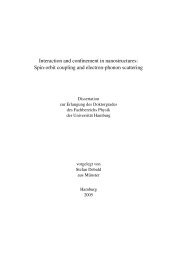Measuring the Electron Beam Energy in a Magnetic Bunch ... - DESY
Measuring the Electron Beam Energy in a Magnetic Bunch ... - DESY
Measuring the Electron Beam Energy in a Magnetic Bunch ... - DESY
Create successful ePaper yourself
Turn your PDF publications into a flip-book with our unique Google optimized e-Paper software.
where d 1 is <strong>the</strong> drift space between <strong>the</strong> first and second dipoles and d 2 is <strong>the</strong> drift space<br />
between <strong>the</strong> second and third dipoles. If <strong>the</strong>se equations are rewritten <strong>in</strong> terms of <strong>the</strong><br />
magnetic field and <strong>the</strong> momentum of <strong>the</strong> electrons (Eqs. 1.1 and 1.3), we have<br />
l<br />
4 p ⎛ l eB ⎞ 2d<br />
( ⎜ ⎟<br />
d<br />
eff<br />
1<br />
BC<br />
p)<br />
= arcs<strong>in</strong><br />
eB ⎜ p ⎟<br />
+<br />
+<br />
2<br />
⎝ ⎠ 1−<br />
( leff<br />
eB / p)<br />
and (1.6)<br />
2B<br />
2<br />
leff<br />
eBd1<br />
xBC<br />
( p)<br />
= ⎜⎛<br />
1−<br />
1−<br />
( leff<br />
eB / p) ⎟ ⎞ +<br />
.<br />
ep ⎝<br />
⎠<br />
2<br />
p 1−<br />
( l eB / p)<br />
Because high-momentum particles’ trajectories are bent less than those of lowmomentum<br />
particles, <strong>the</strong> high-momentum particles will travel a shorter path through <strong>the</strong><br />
chicane and will arrive at <strong>the</strong> end of <strong>the</strong> chicane earlier than <strong>the</strong> low-momentum particles.<br />
We would like to know how a momentum change of a group of particles will affect <strong>the</strong><br />
path-length through <strong>the</strong> chicane and <strong>the</strong> horizontal position <strong>in</strong> <strong>the</strong> chicane. To f<strong>in</strong>d this,<br />
we will Taylor expand Eq.s 1.5 <strong>in</strong> terms of a small change <strong>in</strong> momentum δ=Δp/p. This is<br />
given by<br />
l<br />
x<br />
BC<br />
BC<br />
2 2<br />
∂lBC<br />
p ∂ lBC<br />
2<br />
( p(1<br />
+ δ )) = lBC<br />
+ p ⋅δ<br />
+ ⋅δ<br />
2<br />
∂p<br />
2 ∂p<br />
eff<br />
2<br />
+ ...<br />
2<br />
= l BC<br />
+ R56 ⋅δ<br />
+ R566<br />
⋅δ<br />
+ ...<br />
(1.7)<br />
2 2<br />
∂x<br />
BC p ∂ xBC<br />
2<br />
( p(1<br />
+ δ )) = xBC<br />
+ p ⋅δ<br />
+ ⋅δ<br />
2<br />
∂p<br />
2 ∂p<br />
=<br />
x BC<br />
+ R δ<br />
2<br />
16<br />
⋅δ<br />
+ R166<br />
⋅ +<br />
where R 56 , R 566 R 16 and R 166 are functions of <strong>the</strong> magnetic field and <strong>the</strong> effective length<br />
of each magnet. They are named after <strong>the</strong>ir locations <strong>in</strong> a transfer matrix used to calculate<br />
beam transport and <strong>the</strong>y are used to predict <strong>the</strong> arrival-time and x position changes of<br />
particles travel<strong>in</strong>g through dipole fields for given momentum changes. For short bunches,<br />
like those <strong>in</strong> FELs, <strong>the</strong> R 566 and R 166 terms are typically small compared to <strong>the</strong> R 56 and<br />
R 16 terms. So, for <strong>the</strong> majority of <strong>the</strong> calculations <strong>in</strong> this <strong>the</strong>sis, only <strong>the</strong> first-order terms<br />
will be used. The first order terms are frequently referred to as momentum compaction<br />
(R 56 =ά c ) and l<strong>in</strong>ear dispersion (R 16 =D). Do<strong>in</strong>g <strong>the</strong> first order derivatives of Eqs. 1.6, one<br />
f<strong>in</strong>ds<br />
R<br />
56<br />
=<br />
− 4l<br />
1−<br />
( eBl<br />
eff<br />
eff<br />
/ p)<br />
2<br />
−<br />
2d<br />
1<br />
( eBl / p)<br />
eff<br />
1−<br />
( eBl<br />
/ p)<br />
3 2<br />
eff<br />
2<br />
...<br />
+ ...<br />
4 p ⎛ eBl<br />
+ arcs<strong>in</strong><br />
⎜<br />
eB ⎝ p<br />
eff<br />
⎞<br />
⎟<br />
⎠<br />
(1.8)<br />
2

















